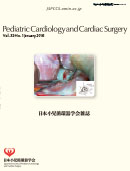Volume 32, Issue 1
Displaying 1-15 of 15 articles from this issue
- |<
- <
- 1
- >
- >|
Editorial
-
2016Volume 32Issue 1 Pages 1-
Published: January 01, 2016
Released on J-STAGE: March 03, 2016
Download PDF (108K)
Reviews
-
2016Volume 32Issue 1 Pages 2-8
Published: January 01, 2016
Released on J-STAGE: March 03, 2016
Download PDF (319K) -
2016Volume 32Issue 1 Pages 9-18
Published: January 01, 2016
Released on J-STAGE: March 03, 2016
Download PDF (1371K)
Originals
-
2016Volume 32Issue 1 Pages 19-25
Published: January 01, 2016
Released on J-STAGE: March 03, 2016
Download PDF (432K) -
2016Volume 32Issue 1 Pages 31-37
Published: January 01, 2016
Released on J-STAGE: March 03, 2016
Download PDF (526K)
Case Reports
-
2016Volume 32Issue 1 Pages 38-42
Published: January 01, 2016
Released on J-STAGE: March 03, 2016
Download PDF (10286K) -
2016Volume 32Issue 1 Pages 43-47
Published: January 01, 2016
Released on J-STAGE: March 03, 2016
Download PDF (1441K) -
2016Volume 32Issue 1 Pages 50-53
Published: January 01, 2016
Released on J-STAGE: March 03, 2016
Download PDF (4569K) -
2016Volume 32Issue 1 Pages 56-61
Published: January 01, 2016
Released on J-STAGE: March 03, 2016
Download PDF (2798K)
Images in Pediatric and Congenital Heart Disease
-
2016Volume 32Issue 1 Pages 62-63
Published: January 01, 2016
Released on J-STAGE: March 03, 2016
Download PDF (1916K)
Editorial Comments
-
2016Volume 32Issue 1 Pages 26-28
Published: January 01, 2016
Released on J-STAGE: March 03, 2016
Download PDF (158K) -
2016Volume 32Issue 1 Pages 29-30
Published: January 01, 2016
Released on J-STAGE: March 03, 2016
Download PDF (137K) -
2016Volume 32Issue 1 Pages 48-49
Published: January 01, 2016
Released on J-STAGE: March 03, 2016
Download PDF (135K) -
2016Volume 32Issue 1 Pages 54-55
Published: January 01, 2016
Released on J-STAGE: March 03, 2016
Download PDF (140K) -
2016Volume 32Issue 1 Pages 64-65
Published: January 01, 2016
Released on J-STAGE: March 03, 2016
Download PDF (138K)
- |<
- <
- 1
- >
- >|
